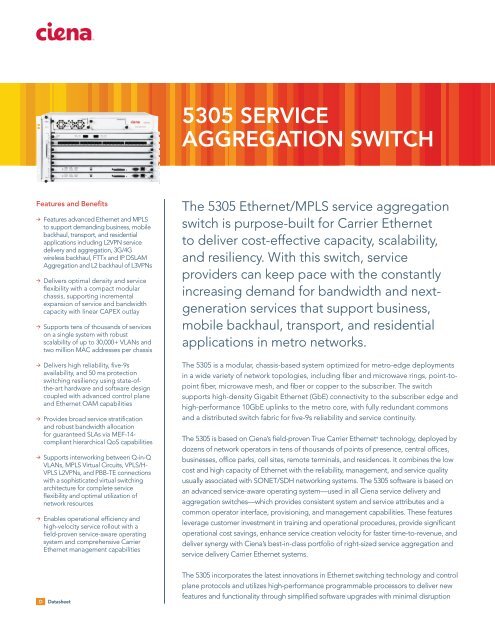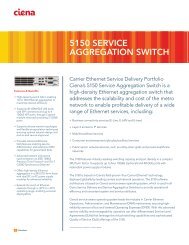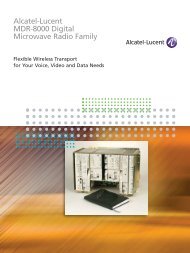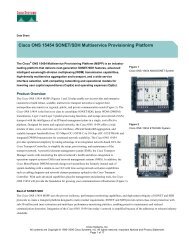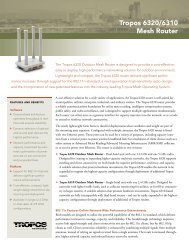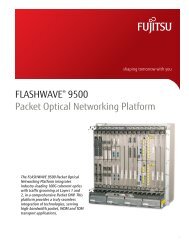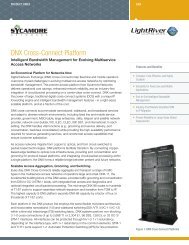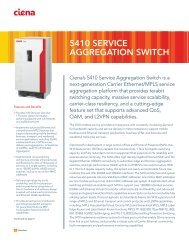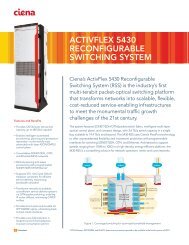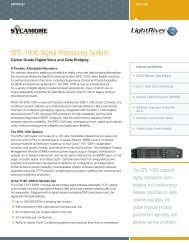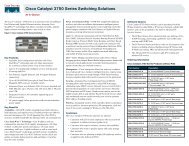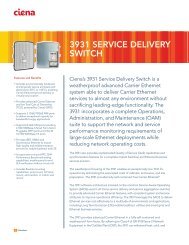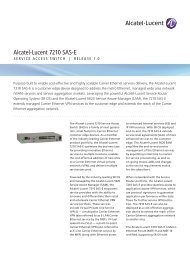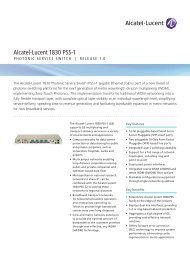Ciena 5305 Service Aggregation Switch datasheet - LightRiver ...
Ciena 5305 Service Aggregation Switch datasheet - LightRiver ...
Ciena 5305 Service Aggregation Switch datasheet - LightRiver ...
You also want an ePaper? Increase the reach of your titles
YUMPU automatically turns print PDFs into web optimized ePapers that Google loves.
<strong>5305</strong> SERVICEAGGREGATION SWITCHFeatures and Benefits> Features advanced Ethernet and MPLSto support demanding business, mobilebackhaul, transport, and residentialapplications including L2VPN servicedelivery and aggregation, 3G/4Gwireless backhaul, FTTx and IP DSLAM<strong>Aggregation</strong> and L2 backhaul of L3VPNs> Delivers optimal density and serviceflexibility with a compact modularchassis, supporting incrementalexpansion of service and bandwidthcapacity with linear CAPEX outlay> Supports tens of thousands of serviceson a single system with robustscalability of up to 30,000+ VLANs andtwo million MAC addresses per chassis> Delivers high reliability, five-9savailability, and 50 ms protectionswitching resiliency using state-ofthe-arthardware and software designcoupled with advanced control planeand Ethernet OAM capabilities> Provides broad service stratificationand robust bandwidth allocationfor guaranteed SLAs via MEF-14-compliant hierarchical QoS capabilities> Supports interworking between Q-in-QVLANs, MPLS Virtual Circuits, VPLS/H-VPLS L2VPNs, and PBB-TE connectionswith a sophisticated virtual switchingarchitecture for complete serviceflexibility and optimal utilization ofnetwork resources> Enables operational efficiency andhigh-velocity service rollout with afield-proven service-aware operatingsystem and comprehensive CarrierEthernet management capabilitiesThe <strong>5305</strong> Ethernet/MPLS service aggregationswitch is purpose-built for Carrier Ethernetto deliver cost-effective capacity, scalability,and resiliency. With this switch, serviceproviders can keep pace with the constantlyincreasing demand for bandwidth and nextgenerationservices that support business,mobile backhaul, transport, and residentialapplications in metro networks.The <strong>5305</strong> is a modular, chassis-based system optimized for metro-edge deploymentsin a wide variety of network topologies, including fiber and microwave rings, point-topointfiber, microwave mesh, and fiber or copper to the subscriber. The switchsupports high-density Gigabit Ethernet (GbE) connectivity to the subscriber edge andhigh-performance 10GbE uplinks to the metro core, with fully redundant commonsand a distributed switch fabric for five-9s reliability and service continuity.The <strong>5305</strong> is based on <strong>Ciena</strong>’s field-proven True Carrier Ethernet ® technology, deployed bydozens of network operators in tens of thousands of points of presence, central offices,businesses, office parks, cell sites, remote terminals, and residences. It combines the lowcost and high capacity of Ethernet with the reliability, management, and service qualityusually associated with SONET/SDH networking systems. The <strong>5305</strong> software is based onan advanced service-aware operating system—used in all <strong>Ciena</strong> service delivery andaggregation switches—which provides consistent system and service attributes and acommon operator interface, provisioning, and management capabilities. These featuresleverage customer investment in training and operational procedures, provide significantoperational cost savings, enhance service creation velocity for faster time-to-revenue, anddeliver synergy with <strong>Ciena</strong>’s best-in-class portfolio of right-sized service aggregation andservice delivery Carrier Ethernet systems.DDatasheetThe <strong>5305</strong> incorporates the latest innovations in Ethernet switching technology and controlplane protocols and utilizes high-performance programmable processors to deliver newfeatures and functionality through simplified software upgrades with minimal disruption
to customer traffic. This programmable architecture keeps capitaland operating costs to a minimum and simplifies the migration toemerging standards and services, maximizing revenue potentialand providing superior flexibility and investment protection.AccessNxGbEQ-in-Q, PBB-TEMPLS/VPLSBroadband (IP DSLAM)<strong>Aggregation</strong>Figure 1. <strong>5305</strong> aggregation networkMetro/<strong>Aggregation</strong>10GbEQ-in-Q, PBB-TEMPLS/VPLS10GbEQ-in-Q, PBB-TEMPLS/VPLSThe <strong>5305</strong> provides unparalleled support for carrier-grade MPLS/VPLS and Ethernet Layer 2 Virtual Private Networks (L2VPNs)thanks to a state-of-the-art feature set that includes sophisticatedhierarchical Quality of <strong>Service</strong> (QoS), advanced Virtual LAN (VLAN)and virtual switching, comprehensive MPLS/VPLS/H-VPLS,resilient PBB-TE connection-oriented Ethernet, and robust CarrierEthernet management and performance monitoring capabilities.The <strong>5305</strong> is the only Carrier Ethernet switch in the industry tosupport interworking between Q-in-Q VLANs, MPLS/VPLS/HVPLS, and PBB-TE encapsulation formats. By enablingEthernet and MPLS VPN and connectivity services toseamlessly traverse multiple domains and transmissionfacilities— each with its own encapsulation and transport—<strong>Ciena</strong>’s <strong>5305</strong> creates interworking functionality that supportscomplete service flexibility and maximum optimization ofnetwork resources and traffic engineering architectures.Compact Modular Scalable System DesignCoreNationalMPLSThe <strong>5305</strong> delivers optimal density and service flexibility bycombining a compact chassis size with high port scalability forGbE and 10GbE interfaces. The seven-slot chassis can supportup to 120 GbE ports or ten 10GbE ports in a space-efficient 6RU (10.5 inches/ 266.7 mm). Two slots in the <strong>5305</strong> chassissupport optionally redundant control modules. The other fiveslots are reserved for GbE and/or 10GbE line modules:> The <strong>5305</strong> GbE line module supports 24 SFP fiber GbE ports(100/1000 Mb/s); these ports can also accommodate RJ-45copper SFPs and 10/100/1000 Mb/s data rates> The <strong>5305</strong> 10GbE line module supports two 10GbE ports(XFP fiber)> Each line module includes a fully distributed switch fabricand functions as an independent switching system, ensuringresiliency and supporting incremental growthHigh-Availability Hardware ArchitectureThe <strong>5305</strong> features a highly available hardware architecture withfully redundant common equipment and distributed controlprocessors and switch fabric:> 1:1 dual redundant system control modules guaranteecontinuous system operation> 1:1 redundant field-replaceable fan trays provide resilientcooling> Front-mounted redundant load-sharing AC or DC powersupply modules ensure uninterrupted power> CPU and switch fabric on each line module ensureuninterrupted traffic forwarding during software upgrades andcontrol module switchover and/or replacement> Distributed switch fabric on each line module and dedicatedcontrol interfaces between the control modules and each linemodule prevent disruption to other line modules or to thecontrol modules in the event of failure of a single line module> A passive backplane provides full mesh connectivity fornonblocking switching> Removable CompactFlash®on the control modules providesfast access to the base operating system kernel, loadmodules, alternate images, and system-specificconfiguration filesSoftware Reliability and ResiliencyThe <strong>5305</strong>’s high availability hardware design is complementedby a modular operating system and advanced softwareresiliency features, as described below:> Modular operating system software has a real-time kerneland is distributed across control and line modules, providingprotection against complete system failures> Carrier Ethernet OAM features, including IEEE 802.1agConnectivity Fault Management (CFM), monitor physicaland logical link status and support 50 ms link and servicerestoration from fault conditions> MPLS OAM capabilities monitor link status and MPLS FastRe-Route (FRR) supports 50 ms link and service restoration> PBB-TE dual homing and backup tunnels support immediateservice switchover in event of primary tunnel failure2
Advanced optimization of the IEEE 802.1w Rapid SpanningTree Protocol (RSTP) delivers sub-50 ms failover times forselected configurations> Support for link aggregation and IEEE 802.3ad Link<strong>Aggregation</strong> Control Protocol (LACP) ensures customer trafficis not disrupted by the failure of one or more physical portsCIR/EIR10/505/5015/5020/2010/5020/100VLAN 100MAC AMAC BVoice VLANData VLANL2VPNFlow Interface(i.e., VLAN or MAC)Carrier-Class Quality of <strong>Service</strong>30/10050/100Sub-Port(i.e., Dept)Figure 2. <strong>5305</strong> hierarchical Quality of <strong>Service</strong>80/200Logical Port(i.e., Business)The <strong>5305</strong> implements MEF-14-compliant hierarchical QoScapabilities that support a wide range of traffic types and ratesover Carrier Ethernet network infrastructures, withoutinterference or degradation. This granular traffic managementenables GbE and 10GbE ports and links to accommodatehundreds of individual services and ensures that <strong>Service</strong> LevelAgreement (SLA) requirements for throughput, latency, jitter,and loss are met even under heavy traffic load conditions.These QoS mechanisms include the following:> Rich classification of traffic flows based on L1 through L4parameters, including physical port, MAC address, VLAN tag,and IP or L4 port addresses> Flexible priority resolution for Class of <strong>Service</strong> (CoS)mapping based on priority settings contained in IP packetheaders and VLAN, MPLS, and PBB-TE tagsAdvanced MPLS FunctionalityThe <strong>5305</strong> offers a comprehensive set of MPLS, VPLS, andH-VPLS features that support resilient MPLS L2VPNs andenable service providers to offer MPLS-based connectivityservices on metro Ethernet networks, extending thefunctionality and scalability of MPLS core networks. TheseMPLS features include:> MPLS Pseudowire Emulation Edge-to-Edge (PWE3), whichsupports MPLS Virtual Private Wire <strong>Service</strong>s (VPWS),sometimes called MPLS Virtual Leased Lines. VPWS enablesthe provisioning of MPLS-based Ethernet Virtual Circuits(EVCs) and supports MPLS-based Ethernet Private Line andEthernet Virtual Private Line services> Virtual Private LAN <strong>Service</strong>s (VPLS) and Hierarchical-VPLS(H-VPLS) based on MPLS Label <strong>Switch</strong>ed Paths (LSPs) and MPLSVirtual Circuits (VCs). <strong>5305</strong> VPLS capabilities support Layer 2VPNs that are based on Ethernet transport with the benefits ofan MPLS/VPLS control plane. This control plane includes LabelDistribution Protocol (LDP) for VPLS VC signaling; OSPF-TE andIS-IS-TE for MPLS Tunnel Routes; and RSVP-TE for theestablishment of the LSPs that constitute the VPLS> MPLS label edge router functionality, which enables the <strong>5305</strong>to function as a VPLS/H-VPLS Provider Edge switch (PE-rs)and as an H-VPLS MTU-s customer edge switch. The <strong>5305</strong>also supports H-VPLS Dual Homing, which providesresiliency by enabling spoke connections from an MTU-s totwo different PE Hub switches. For additional flexibility,H-VPLS spoke connections can be implemented using MPLSpseudowires (VCs), Q-in-Q Ethernet VLAN Virtual Circuits,Ethernet Private Lines, Ethernet Virtual Private Lines andPBB-TE service instances> MPLS tunnel groups can be configured on the <strong>5305</strong> to supportLSP redundancy> Sophisticated hierarchical ingress metering for CommittedInformation Rate (CIR), Excess Information Rate (EIR),Committed Burst Size (CBS), and Excess Burst Size (EBS)EthernetH-VPLS MTU-sVPLS PEVPLS PEH-VPLS MTUsEthernet> Two-rate Three-Color Marking (TrTCM) and Weighted RandomEarly Drop (WRED) for sophisticated congestion handling> Hierarchical shaping and queue scheduling, including StrictPriority (SP), Weighted Round Robin (WRR), and a mix of SPand WRR scheduling modes> Eight hardware queues per port, with over 8,000 virtualoutput queues per system<strong>5305</strong> QoS mechanisms, as shown in Figure 2, supportenhanced revenue generation by ensuring the efficientutilization of available network resources, and deliverscustomer satisfaction based on enforceable and reliable SLAs.Ethernet AccessVPLS PEH-VPLS MTUsFigure 3. <strong>5305</strong> MPLS/VPLS serviceMPLS LSPH-VPLS Hub PseudowireH-VPLS Spoke PseudowireQ-in-Q/PBB-TE TunnelVLAN/PBB-TE PseudowireEthernet Access3
MPLS FRR further enhances resiliencyfor MPLS/VPLS services by enabling LSPsto be restored within 50 ms in case ofphysical or logical link failureAccess/<strong>Aggregation</strong>MPLS/H-VPLS,Q-in-Q, PBB/TEMetro/CoreMPLS/H-VPLS,Q-in-Q, PBB/TEAccess/<strong>Aggregation</strong>MPLS/H-VPLS,Q-in-Q, PBB/TE> MPLS OAM capabilities include LSP Pingand LSP Traceroute, which can be usedto verify the LSP status and topologyVLANMPLS LSPDual tagpush/pop/stampMPLS LSPDual tagpush/pop/stampEVCEVC (PW) MPLS LSPVLANThe <strong>5305</strong>’s MPLS/VPLS capabilities arecomplemented by the MPLS/VPLS featureson the LE-311v <strong>Service</strong> Delivery <strong>Switch</strong>,allowing network operators to deploy acost-effective mix of LE-311v and <strong>5305</strong>systems within their network infrastructuresto support carrier-grade VPLS, H-VPLS, VPWS,and MPLS interworking services, as shown in Figure 3.Industry-leading Interworking CapabilitiesVLANVLANIn addition to the MPLS/VPLS/H-VPLS/VPWS features notedabove, the <strong>5305</strong> supports the interworking of customer andprovider (Q-in-Q) VLAN services and EVCs with MPLSpseudowires and VPLS VPN services. This enables networkoperators to deploy VPWS, H-VPLS, and/or VPLS VPN servicesto targeted customers while providing Ethernet VLAN and VPNservices on the same <strong>5305</strong> platform. The <strong>5305</strong> also supportsthe interworking of MPLS LSPs, pseudowires, and VPLS VPNswith PBB-TE service instances and tunnels, including supportfor PBB-TE spokes to interwork with VPLS mesh LSPs.Q-in-Q / PBB-TE TunnelQ-in-Q / PBB-TE TunnelMPLS LSPto a fast-growing customer base. The <strong>5305</strong> PBB-TEimplementation has the following elements:> IEEE 802.1ah PBB MAC-MAC frame format, includingbackbone VLAN IDs for tunnel routing, and a serviceinstance field that can support up to 16 million individualservices within a single PBB-TE network> PBB-TE tunneling protocol with built-in backup tunnels anda dual homing tunnel optionEVCQ-in-Q / PBB-TE Tunnel EVCFigure 4. <strong>5305</strong> VLAN/Q-in-Q/PBB-TE/MPLS interworkingEVC Q-in-Q (PW)/ PBB-TE TunnelEVC Q-in-Q (PW)/ PBB-TE Tunnel> PBB-TE tunnel monitoring and 50 ms failover via IEEE802.1ag Continuity Check Messages (CCMs)VLANVLAN> Advanced management mechanisms that support theprovisioning of PBB-TE service instances and enableprovider networks to deliver point-to-point services with highlevels of scalability, reliability, manageability, and securityThe breadth and sophistication of the <strong>5305</strong>’s MPLS/VPLSfeatures and its support for the interworking of MPLS/VPLS,PBB-TE, and VLAN/Q-in-Q services firmly establishes the<strong>5305</strong> as the industry-leading Carrier Ethernet service deliveryand aggregation platform. No other product currentlysupports MPLS/VPLS, VLAN, EPL/EVPL/ELAN/E-Tree, andPBB-TE services on one system, and no other productsupports interworking between all these connection typesover its Ethernet interfaces, as shown in Figure 4.PBB-TE: Connection-Oriented Carrier Ethernet TransportAs mentioned above, the IEEE 802.1Qay PBB-TE specificationincludes support for built-in backup tunnels to ensure theavailability of a predictable tunnel route over the backbone,with normal and failover paths. The <strong>5305</strong>’s PBB-TEimplementation uses 802.1ag CFM mechanisms to detectfaults and achieve 50 ms service restoration times comparableto those available with SONET/SDH.Figure 5 illustrates a typical PBB-TE application with tunnel andpath redundancy; the tunnels are explicitly routed, which ensuresPBB-TE is an innovative technology that extends and adaptsEthernet to provide carrier-grade transport over Metro andWide Area Networks (MANs and WANs). PBB-TE has beenstandardized as IEEE 802.1Qay, and the <strong>5305</strong> is fully compliantwith this new industry standard.The <strong>5305</strong>’s advanced PBB-TE feature set delivers a reliable,resilient, and cost-effective connection-oriented Ethernettransport solution, ideal for delivering a variety of new servicesPrimary TunnelBackup TunnelPrimary TunnelContinuity Check MessagesPBB-TEBackup TunnelContinuity Check MessagesFigure 5. PBB-TE primary and backup tunnels4
superior management visibility and enhanced fault isolation. Abroad array of <strong>Ciena</strong> Carrier Ethernet switches can be utilized tobuild PBB-TE networks, including the <strong>5305</strong>, the 3960, the 3940,the 5140, and the LE-311v.Based on extensions to current Ethernet standards, PBB-TEenabledproducts maintain compatibility with existing Ethernetdeployments, which means that the <strong>5305</strong> can deliver resilientPBB-TE connection-oriented Ethernet services with guaranteedQoS to thousands of customers while interoperatingseamlessly with an installed base of multi-vendor switching androuting systems that do not support PBB-TE. Because theadvantages of PBB-TE are available without changes toexisting network equipment or architectures, the <strong>5305</strong> canprovide PBB-TE resiliency and traffic engineering benefits whileensuring superior investment protection.Flexible VLAN and MEF <strong>Service</strong>sIn addition to the comprehensive MPLS/VPLS and PBB-TEcapabilities noted above, the <strong>5305</strong> has a robust Ethernet L2VPNfeature set that includes 802.1Q VLANs, 802.1ad ProviderBridging (Q-in-Q VLANs), and advanced VLAN tag manipulationand mapping capabilities. These VLAN features enableprovisioning of MEF-standard Ethernet Private Line, EthernetVirtual Private Line, Ethernet-LAN (E-LAN), Ethernet VirtualPrivate LAN (EVP-LAN), and Ethernet-Tree (E-Tree) services.The <strong>5305</strong>’s highly flexible VLAN tag manipulation and mappingincludes VLAN ID translation, dual-tag insertion, removal, andmarking (sometimes called “push-pop-stamp”), CoS markingand re-marking, L2 to L3 and L3 to L2 CoS mapping andre-marking, and the ability to perform push, pop, and stampoperations for two or more levels of VLAN tags.Sophisticated Virtual <strong>Switch</strong> ArchitectureThe <strong>5305</strong> has a sophisticated virtual switching architecture thatenables every port to be an independent VLAN, MAC, and IPaddress domain, and allows overlapping VLAN and IP addressesto be configured on different <strong>5305</strong> ports. In addition, each virtualswitch is an independent switching and bridging domain.This enables customers to maintain private VLAN and IPaddressing schemes and insures security and separation ofcustomer traffic for L2VPNs (E-LAN, E-Tree) and EVCs (EPL,EVPL). This arrangement enables the <strong>5305</strong> to support VLANsfrom many customers on each physical port, up to 4,094 VLANson each Virtual <strong>Switch</strong>, and up to 30,000 VLANs per <strong>5305</strong>system, for unparalleled service scalability and flexibility. The<strong>5305</strong> architecture and system resources can also support up to500,000 unique MAC addresses per line module and up to twomillion MAC addresses per system.PBB-TE MACin-MACDomainMAC AddressDomainVLAN(.1Q, Q-in-Q)Tag DomainThe following points summarize the key characteristics andcapabilities of the <strong>5305</strong>’s virtual architecture and advancedVLAN feature set:> Every virtual switch is an independent broadcast/floodingdomain> Every port is an independent VLAN, MAC, and IP addressdomainMPLS/VPLS/H-VPLSDomain> Support for more than 4,094 simultaneous VLANs per port,and 30,000 VLANs, 10,000 virtual switches, and 30,000 QoSflows per system> Each port and virtual switch can accommodate a mix ofuntagged, VLAN, and Q-in-Q VLANs, as well as MPLS andPBB-TE services> Customer-, service-, and network-level priority treatmentusing flexible priority marking> Flexible tag manipulation, including untagged, single, anddouble-tagged combinations, natively or tunneled> Low- or zero-touch provisioning using pre-provisionedVLAN(s) and Q-in-Q attachments> Logical flows and traffic treatment using flexible flowclassification> Flexible E-Type manipulation to suit various applicationenvironmentsMetro 1 Metro 2Figure 6. <strong>5305</strong> Virtual <strong>Switch</strong>ing> Subscriber identity and server parameter conservation,to suit carrier network requirements> Full MEF-compliant services for all different tagging schemesCarrier-Class Ethernet OAMThe <strong>5305</strong> supports a rich set of OAM features defined in thelatest versions of IEEE, ITU, and IETF standards, including:> IEEE 802.3ah EFM physical layer OAM, including link eventsand remote loopbackVS 1 VS 2PBB-TE MACin-MACDomainMAC AddressDomainAddresses and Tags can be reused in each Virtual <strong>Switch</strong>VLAN(.1Q, Q-in-Q)Tag DomainMPLS/VPLS/H-VPLSDomain5
IEEE 802.1ag CFM, including CCMs, MAC Ping, MACTraceroute, Maintenance Domains, Maintenance Endpoints(MEPs), Maintenance Intermediate Points (MIPs), and more> ITU Y.1731 L2 performance management capabilities,including packet jitter, latency, delay, and throughputmeasurements> IETF Two-Way Active Management Protocol (TWAMP) thatsupports end-to-end performance measurement forconnections that traverse L3 core networksThese capabilities enable the <strong>5305</strong> to monitor the status ofsystem and network links; confirm link and service throughputand quality conform to SLAs; measure the performance ofcustomers’ Ethernet services; and distribute this managementinformation across point-to-point, point-to-multipoint, andmultipoint-to-multipoint connections.Field-Proven <strong>Service</strong>-Aware Operating SystemThe <strong>5305</strong> software architecture is based on a service-awareoperating system used in all <strong>Ciena</strong> service delivery andaggregation switches. Efficient, resilient, and modular, thisoperating system is purpose-built to support demanding serviceprovider network environments. The system is multi-layered,allowing for the separation of management, control, and dataplanes to ensure intelligent fault recovery. The real-time kerneland distributed-processing architecture delivers reliability andhigh availability by protecting against complete operatingsystem and module failures, while conforming to stringentuptime and service continuity requirements.<strong>Ciena</strong>’s service-aware operating system provides anexpandable carrier-class software infrastructure that integratestightly with the <strong>5305</strong>’s virtual switching architecture to supportcomprehensive Carrier Ethernet features and consistentservices across all access and aggregation platforms andapplications. Benefits include:> Rapid implementation of the latest advances in Ethernettechnologies and new features, services and standards asproposed by the IEEE, IETF, and MEFMulti-Layer Configuration & ActivationMulti-Layer Discovery, Topology & InventoryElement Link Connectivity <strong>Service</strong>> E-Line (EPL, EVPL), E-LAN> E-Tree> Class of <strong>Service</strong> and <strong>Service</strong> Profiles> Composite <strong>Service</strong>s (ETH+PBT+MPLS)> Flow, Flow Domain, Fragments and Paths> EVC, QoS Profiles> Virtual Interface and Virtual <strong>Switch</strong>> Bridging Domains (STP, RSTP)> Assurance and Validation> EOAM, CFM, Y.1731> ETH Links and Trunks> UNI, NNI, E-NNI> Bandwidth Profiles> SFPs, Cards, Chassis> Software> Physical and Logical PortsFigure 7. ESM features and functionality> Improved efficiency and cost savings resulting from acommon deployment and service provisioning model andreduced need for hybrid network architectures> A common management interface that supports rapidservice creation and offers improved productivity byleveraging existing personnel training> Interoperability with Ethernet equipment from other vendors> Consistent service offerings across all <strong>Ciena</strong> CarrierEthernet switches, permitting rapid service rollout acrossan entire networkEthernet <strong>Service</strong>s Manager (ESM)<strong>Ciena</strong>’s ESM is a groundbreaking carrier-grade, automatedservice activation, creation, and management platform forservice delivery and aggregation networks. The ESM allowsusers to build and deploy large-scale Carrier Ethernet networksquickly and easily— cutting time to market for new services;accelerating service revenue; maximizing service availability;assuring service quality; leveraging existing systems; andenabling subscriber-managed services. These functionscombine to cut total cost of ownership for increased revenueand competitiveness.6
Technical InformationInterfaces24 x 100/1000M SFP NNI/UNI ports per GbELine Module- 0-5 GbE line modules per system- 0/24/48/96 or 120 x GbE ports per system2 x 10GbE XFP NNI/UNI ports per10GbE Line Module- 0-5 10GbE line modules per system- 0/2/4/8 or 10 x 10GbE ports per system1 x 10/100/1000M RJ-45 Managementport per Control Module1 x Console Port (RS-232) per Control ModuleMAC Address Table Capacity750,000 MAC addressesEthernetIEEE 802.3 EthernetIEEE 802.3u Fast EthernetIEEE 802.3z GbEIEEE 802.1D MAC BridgesIEEE 802.1Q VLANs - Including .1p PriorityIEEE 802.1ad Provider Bridging (Q-in-Q)VLANs with full S-VLAN range4,094 Simultaneous VLANs per port30,000+ Simultaneous VLANs per systemSingle and double VLAN tag push and pop oningress and egressSingle and double VLAN tag translations oningress and egressPrivate Forwarding Groups/Private VLANsVirtual pipe/2-port VLANPer Virtual <strong>Switch</strong> MAC Learning ControlPer VLAN MAC Learning Control81-00, 91-00, 88-a8 Ethertype SupportIEEE 802.3x Ethernet Flow ControlIEEE 802.1w Rapid Spanning Tree Protocol(RSTP) - now in .1DRSTP Path Cost & Self DisableSpanning Tree DomainsIEEE 802.3ad Link <strong>Aggregation</strong> ControlProtocol (LACP)Manual Link <strong>Aggregation</strong> (LAG)N+N Protection LAGJumbo Frames to 9216 bytesLayer 2 Control Frame TunnelingMEF 9 Ethernet Private LineMEF 9 Ethernet Private LANMEF 9 Ethernet Virtual Private LineMEF 9 Ethernet Virtual Private LANMEF 9 Ethernet TreeMEF 14 Traffic ManagementCarrier Ethernet OAMIEEE 802.1ag Connectivity FaultManagement (CFM)Distributed Connectivity Fault ManagementCFM over Q-in-QCFM for PBB-TE Tunnel MonitoringIEEE 802.3ah Ethernet in the First Mile (EFM)IEEE 802.1AB Link Layer DiscoveryProtocol (LLDP)Y.1731 Performance MonitoringIngress Port Mirroring with Port StateMirror GroupsMPLS/VPLSMPLS Pseudowire EmulationEdge-to-Edge (PWE3)MPLS Virtual Private Wire <strong>Service</strong> (VPWS)VPLS (Virtual Private LAN <strong>Service</strong>) andHierarchical VPLS (H-VPLS)Provider Edge (PE-s) Functionality for VPLSand H-VPLSVPLS with multiple VPLS Mesh Virtual CircuitsH-VPLS with Hub and Spoke Virtual CircuitsMTU-s Functionality for H-VPLS deploymentMTU-s Multihoming (redundant VCs todifferent PE-s switches)MPLS Virtual Circuit as H-VPLS spokeVirtual CircuitPBB-TE <strong>Service</strong> Instance as H-VPLSspoke Virtual CircuitQ-in-Q Ethernet Virtual Circuit as H-VPLSspoke Virtual CircuitMPLS Label <strong>Switch</strong> Path (LSP) Tunnel GroupsMPLS Label <strong>Switch</strong> Path (LSP) Tunnel RedundancyLayer 2 Control Frame Tunneling over MPLSVirtual CircuitsRSVP-TE (for MPLS Tunnel Signaling)OSPF-TE (for MPLS Tunnel Routes)IS-IS-TE (for MPLS Tunnel Routes)LDP & Targeted LDP (for VPLS VC signaling)MPLS Fast ReRoute (via RSVP-TE)MPLS Performance MonitoringLSP PingLSP TracerouteMPLS SNMP supportPBB-TEIEEE 802.1Qay PBB-TEIEEE 802.1ah PBB frame formatPBB-TE Backup TunnelsPBB-TE Tunnels on Link Agg Logical PortsPBB-TE Multi-homed Protection FailoverIEEE 802.1ag CFM for PBB-TE TunnelsIEEE 802.1ag CFM for PBB-TE <strong>Service</strong> InterfacesPBB-TE Full B-VID & I-SID address rangesPBB-TE Tunnel & <strong>Service</strong> meteringMPLS/VPLS, VLAN/Q-in-Q, PBB-TEInteroperabilityMPLS/VPLS/H-VPLS interoperability withVLAN/Q-in-QMPLS/VPLS/H-VPLS interoperability with PBB-TEPBB-TE interoperability with VLAN/Q-in-Q<strong>Switch</strong>ing between MPLS Virtual Circuits andPBB-TE <strong>Service</strong> Instances<strong>Switch</strong>ing between MPLS Virtual Circuits andQ-in-Q Ethernet Virtual Circuits<strong>Switch</strong>ing between PBB-TE <strong>Service</strong> Instancesand Q-in-Q Ethernet Virtual CircuitsQuality of <strong>Service</strong>8 Hardware Queues per PortCommitted and Excess Information Rate(CIR and EIR)Committed and Excess Burst Size (CBS and EBS)Per-port QoS with CIR and EIR traffic onEgress QueuesHierarchical Ingress metering: per-port/per-VLAN/per-PCP30,000 Hierarchical Ingress Meters per SystemPer-Port/per-PCP Priority OversubscriptionTwo-Rate Three-Color MarkingClassification on IEEE 802.1D priorityClassification on IEEE 802.1ad PCP priorityClassification on IEEE 802.Qay PCP priorityClassification on IP Precedence, IP DiffServCode Point (DSCP)Classification on MPLS EXP-PCPClassification on PBB-TE ISID-PCPClassification on MAC SA/MAC DAClassification on EthertypeClassification on VLAN ID and source portLayer 2 – Layer 3 Class of <strong>Service</strong> Mapping/Marking/Re-markingLayer 3 – Layer 2 Class of <strong>Service</strong> Mapping/Marking/Re-markingPer-Port and per-Subport WRED Egress QueuingConfigurable WRED profilesHierarchical Egress Shaping and SchedulingConfigurable Scheduler PolicyUser-definable Frame to ResolvedCoS mappingsMulticast ManagementIGMPv2 with IGMP Snooping (RFC 2236)IGMP DomainsIGMP Message FilteringIGMP Inquisitive LeaveIGMP Query EngineBroadcast/Multicast Storm ControlUnknown Multicast FilteringWell-known Protocol ForwardingBroadcast/Multicast Containment Statistics7
Technical Information continuedNetwork ManagementEnhanced CLICLI-based configuration filesManagement VLANSNMP v1/v2c/v3SNMPv3 Authentication & Message EncryptionSNMP MIB II (RFC 1213)Bridge MIB (RFC 1493)Ethernet-like Interface MIB (RFC 1643)MIB II interfaces (RFC 1573)IEEE 802.1AB-2005 LLDP-MIB ITU X.733 / RFC3877 Alarm Reporting MIBRMON MIB (RFC1757) - inc. persistentconfigurationRMON II (RFC 2021)RMON StatisticsPer-VLAN StatisticsRADIUS Client & RADIUS AuthenticationTACACS + AAADHCP Client (RFC 2131)DHCP RelayNTP Client (RFC 1305)DNS Client (RFC 1035)Telnet ServerSecure File Transfer Protocol (SFTP)Trivial File Transfer Protocol (TFTP)Secure Shell (SSHv2)Syslog with Syslog AccountingCPU Load QueryDevice ArchiveLocal Console PortAlarm management with audibleand visible alarm outputsUser configuration (including escalationpolicies*) of event/alarm informationFault log for Fault Policy ManagementLog events to FLASH, compact-FLASH orinternal memory (RAM)Local management interfacePhysical Interface Performance MonitoringLogical Interface Performance MonitoringLogical Interface Port & Subport StatisticsLogical & Physical Port RMON StatisticsRemote management interfaceComprehensive Management via Ethernet<strong>Service</strong>s Manager<strong>Service</strong> SecurityPer-port <strong>Service</strong> Access Control (ACLs)Per-VLAN <strong>Service</strong> Access Control (ACLs)Per-flow <strong>Service</strong> Access Control (ACLs)Layer 2, 3 & 4 Access PoliiciesEgress Port RestrictionLayer 2, 3, 4 Protocol FilteringBroadcast ContainmentUser Access RightsSystem High Availability1:1 Dual Redundant System Control Modules1:1 Redundant Fan Trays provideresilient coolingAll Modules Hot Swappable &Field ReplaceableFront-mounted redundant load sharing AC orDC power supply modulesCPU and switch fabric on each line moduleDistributed <strong>Switch</strong> Fabric on each line modulePassive backplane provides full meshconnectivity for non-blocking switchingDedicated control interfaces between ControlModules and each Line ModuleBoot from compact FLASH: operating systemkernel, load modules, alternate images,configuration filesAlarm Module with interface to external alarmsPower RequirementsAC Voltage Input Range: 100V to 240V ACAC Line Frequency Input Range: 50Hz to 60 HzMaximum Power Input: 1000 WattsDC Voltage Input Range: -40V to -59V DCRedundant hot-swappable AC or DCpower suppliesAgency ApprovalsSafety Certifications:NRTL (TUV Rheinland)European Union, CE mark (Declaration ofConformity)UL 60950-1 (US)IEC 60950-1 (International)EN 60950-1 (EU)CAN/CSA 22.2 No. 60950-1-03 (Canada)NEBS:Level 3 Compliant & CertifiedEmissions:FCC 47CFR Part 15 Class AFCC Part 15:1998 Class AEN55022 (1994) Class AEN55022 (2006) Class A;ETSI/EN 300 386:V1.3.2 (2003-05) (EUTelecommunication Emissions and Immunity)Immunity:ETSI/EN 300 386:V1.3.2 (2003-05) (EUTelecommunication Emissions and Immunity)EN 55024 1998 + A1:2001 + A2:2003Environmental:RoHS 2002/95/ECWEEE 2002/96/ECLaser Safety:LCDRH Letter of Approval (US FDA Approval)FCC 21 CFR subpart (J) (Safety of LaserProducts)Europe: EN60825-1:1994 +A11:1996+A2:2001(European Safety of Lasers)Environmental CharacteristicsOperating Temperature: +32°F to +104°F(0°C to +40°C)Storage temperature: -13°F to +158°F(-25°C to +70°C)Relative Humidity: 5% to 90% Non-condensingSide-to-side air flowPhysical CharacteristicsDimensions: 10.5” (H) x 17.6 (W) x 15.75” (D)266.7 mm (H) x 447 mm (W) x 400 mm (D)Weight: 88 lbs; 39.9 kg (fully loaded)<strong>Ciena</strong> may from time to time make changes to the products orspecifications contained herein without notice. Copyright © 2011<strong>Ciena</strong>® Corporation. All rights reserved. DS141 7.2011Networks that changethe way you compete.1201 Winterson RoadLinthicum, MD 210901.800.207.3714 (US and Canada)1.410.865.8671 (outside US and Canada)+44.20.7012.5555 (international)www.ciena.com


